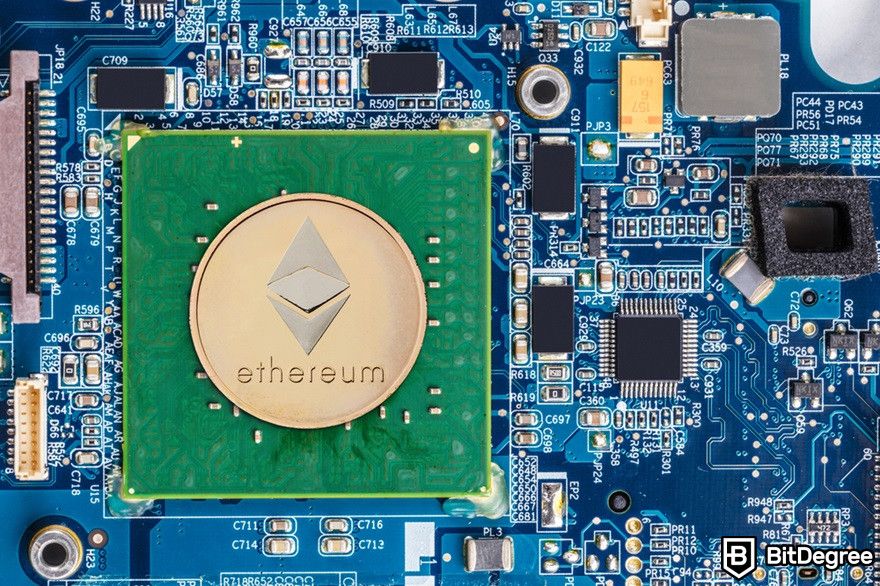Key Takeaways
- The answer to the question “Why is crypto bad for the environment?” lies in the way it uses a huge amount of energy for mining and the reliance on fossil fuels to power that process;
- Some countries make sustainable regulations to minimize the crypto environmental impact, such as banning the use of coal-fired power plants for mining and encouraging renewable sources;
- The crypto community comes up with eco-friendly solutions by using more sustainable consensus mechanisms and exploring alternative energy sources.
Stop overpaying - start transferring money with Ogvio. Sign up, invite friends & grab Rewards now! 🎁
Crypto's been hugely popular lately, promising a whole new way to manage our money. But hold on, there's another side – many say this industry holds a hidden, negative impact on the environment. So, the big question is: Why is crypto bad for the environment, and can it ever be eco-friendly?
In this article, we'll explore the crypto environmental impact and new ideas popping up to make it greener.
If you want to start your crypto journey with a greener conscience, use platforms like Binance that are taking steps towards a more sustainable future. Its initiatives, such as Binance Charity, support environmentally conscious projects like planting trees and initiating funding projects.

Did you know?
Subscribe - We publish new crypto explainer videos every week!
What is IOTA's Tangle? IOTA & mIOTA Animated Explainer


Table of Contents
- 1. Why Is Crypto Bad for the Environment?
- 1.1. High Energy Consumption and Carbon Footprint
- 1.2. E-Waste
- 1.3. Environmental Degradation
- 1.4. Water Consumption
- 2. Regulatory Implications and Responses
- 3. Alternative Cryptocurrencies and Other Sustainable Solutions
- 3.1. Less Energy-Intensive Consensus Mechanisms
- 3.2. More Sustainable Solutions
- 4. Conclusions
Why Is Crypto Bad for the Environment?
A short answer to the question, "Why is crypto bad for the environment?" is that the energy consumption required to power the technology behind crypto, especially traditional mining methods, is excessive and often relies on non-renewable energy sources.
Latest Deal Active Right Now:The combination of excessive energy use and dependence on fossil fuels leads to various environmental concerns, including increased carbon footprints and resource scarcity. Let's explore these issues in more detail below!
High Energy Consumption and Carbon Footprint
To answer the question, “Why is crypto bad for the environment?”, you should understand the concept of consensus mechanisms first.
To ensure the security and integrity of cryptocurrencies, consensus mechanisms are necessary. These mechanisms build agreement on the state of the blockchain (who owns what coins) among all participants in the network.
One of the popular mechanisms is Proof-of-Work (PoW), as a wide range of established cryptocurrencies use it, including Bitcoin and Litecoin. This mechanism uses a lot of computer power to validate transactions and keep the crypto network safe.
PoW’s computer power needs specialized hardware (mining rigs) that consume huge amounts of electricity, like running tons of powerful computers non-stop.
Bitcoin, which uses PoW, for example, needs 143.09 terawatt-hours (TWh) of electricity annually, which is equivalent to more than what Finland uses with over 5 million people.

This high energy demand raises the question: Is crypto mining bad for the environment? Well, in some cases, the answer is "yes" because high energy consumption typically translates to a high carbon footprint – the total amount of greenhouse gases, primarily CO2, generated by an individual, organization, or activity.
The vast majority of electricity generation today comes from fossil fuels like coal, natural gas, and oil. It releases greenhouse gases (CO2) when burned.
So, the more electricity used, the more fossil fuels are needed, leading to more CO2 emissions and a bigger carbon footprint.
Although various consensus mechanisms appear, many cryptos still use PoW, which makes the issue extend beyond Bitcoin[1].
Cryptocurrencies and applications that use similar energy-intensive PoW models all add to greenhouse gas emissions. Monero, for example, may consume more than 600 GWh of electricity in a year, which translates to carbon emissions of around 19 thousand tons per year.
So, why is crypto bad for the environment, again? It’s because a large carbon footprint generated from crypto mining can contribute to several negative effects, both environmental and potentially human-related, such as:
- Climate change. Greenhouse gases like CO2 trap heat in the atmosphere, which raises global temperatures. This warming can mess with weather patterns, melt ice, and cause the oceans to rise.
- Ocean acidification. As CO2 is mixed with the oceans, it makes them more acidic. This can harm marine ecosystems and shellfish populations.
- Air pollution. Burning fossil fuels also releases other pollutants like nitrogen oxides and sulfur oxides, contributing to smog, acid rain, and respiratory problems.

- Extreme weather events. Climate change caused by a large carbon footprint can lead to more frequent and intense weather events like heatwaves, droughts, floods, and wildfires.
- Water scarcity. Rising temperatures and changing weather patterns can lead to water scarcity, impacting agriculture, human health, and sanitation.
- Food security. Climate change can disrupt agricultural production and food security, particularly in vulnerable regions.
From this point of view, no wonder people often ask, “Why is crypto bad for the environment?” because the high energy consumption and its link to greenhouse gas emissions raise concerns, especially when we often experience the effects of climate change recently, like heatwaves, wildfires, and rising sea levels.
E-Waste
The specialized hardware used for PoW mining, known as ASICs (Application-Specific Integrated Circuits), becomes outdated fast. This happens because mining difficulty keeps changing, and newer, better computers for mining come out all the time.
Due to their short lifespans, lots of electronic waste (e-waste) piles up. These devices contain toxic chemicals[2] like lead, mercury, and rare earth elements, which can lead to environmental and health risks if not disposed of properly, such as:
- Landfill contamination. Improper disposal of e-waste in landfills can lead to hazardous materials leaking into the soil and groundwater. This contamination can harm plants and animals, and potentially even enter the food chain.
- Air and water pollution. Burning or improperly recycling e-waste can release toxic fumes and chemicals into the air and water, which can damage water ecosystems, and pose health risks to people living nearby.

- Resource depletion. Making new mining computers needs the mining of raw materials, including rare earth elements. Improper disposal of e-waste means these valuable resources are not recycled and may lead to shortages in the future and increased environmental damage from having to extract even more materials.
So, if you ask, “Why is crypto bad for the environment?”, the answer is that the high energy consumption of PoW mining fuels this e-waste problem that can pollute and damage our environment.
Miners will always need more powerful and efficient hardware, which leads to the production of more ASICs and results in a larger volume of e-waste to manage.
Environmental Degradation
While the question "Why is crypto bad for the environment?" often focuses on carbon footprints and e-waste, the impact goes deeper. Large-scale mining operations can cause a broader environmental degradation. Imagine taking a giant bite out of a cake. That's kind of what large-scale mining operations do to the environment.
To reach the valuable minerals underground, they need to clear a lot of land, which can lead to:
- Deforestation. Forests are cut down to make way for mining sites, which can destroy habitats for animals, disrupt natural water cycles, and contribute to climate change.
- Soil erosion. Removing trees and vegetation leaves the soil exposed to wind and rain. This can lead to soil erosion, which washes away valuable topsoil and nutrients and causes sedimentation problems in rivers and streams that harm aquatic life.
Besides deforestation and soil erosion, crypto-mining farms can also produce huge amounts of heat as a byproduct of their operation – which adds another layer to the question, “Why is crypto bad for the environment?”.
The computers are constantly solving complex math problems to keep the cryptocurrency network running. This intense work uses a lot of energy, which gets released as heat inside the machines.

Moreover, mining farms often cram a huge number of computers into a tight space. This lack of airflow traps the heat generated by each machine, making the entire facility hot.
Finally, the heat can increase ambient air and water temperatures surrounding the facility, which can affect local environments and ecosystems:
- Habitat alteration. Increased temperatures can disrupt the balance of ecosystems. Species that live in specific temperature ranges may be forced to relocate or experience population decline.
- Reduced water quality. Warmer water bodies hold less dissolved oxygen, which is crucial for aquatic life. This can lead to stress and potential die-offs of fish and other aquatic organisms.
- Urban heat island effect. In urban areas, the cumulative heat generated by buildings and infrastructure, including mining farms, can exacerbate the urban heat island effect. This phenomenon creates a hotter microclimate within the city compared to surrounding rural areas.
The severity of these impacts depends on the location and regulations. If mining facilities operate in areas with weak environmental regulations, the risk of deforestation, soil erosion, and heat generation will be much higher.
Water Consumption
Why is crypto bad for the environment besides environmental degradation? From the previous section, you know that large-scale crypto-mining operations generate a lot of heat. To keep them from overheating and malfunctioning, they need constant cooling, often through water-based systems.
This cooling process can consume a significant amount of water. Estimates vary, but a report shows that the mining activity of Bitcoin in the US consumes up to 120 GL of fresh water annually, which is enough to supply 300,000 households.
This can strain local water resources and potentially lead to water shortages, especially in dry regions. These areas are already facing water scarcity due to low rainfall and limited freshwater resources.

The additional water demand from large-scale crypto-mining operations can put a major strain on these already stressed water supplies. It’s like taking a long shower when there's barely any water left in the tank!
Many arid regions rely on groundwater reserves for their water needs. So, excessive water use by mining operations can quickly drain the stores, making it even harder to get water for people in the area. This potentially leads to environmental problems like land subsidence (ground sinking).
Also, if they don’t manage the wastewater properly, it can pollute the rivers and streams, which can make the water unsafe for drinking or irrigation.
Regulatory Implications and Responses
One of the major downsides of cryptocurrency is its environmental impact, and a big part of the answer to the question, "Why is crypto bad for the environment?" lies in the decentralized and globalized nature of crypto mining. Unlike traditional industries with regulations that vary by country, crypto mining operates in a free-for-all.
Here's the issue: some countries have strict environmental laws, while others have practically none. This inconsistency creates a situation where miners can simply relocate to regions with lax regulations and minimal environmental oversight. This is attractive because mining farms require a lot of electricity, and miners naturally seek out cheap and reliable sources of power[3].
So, if you have the following question, “Is crypto mining bad for the environment?” after knowing the issue, China's crackdown on crypto mining operations illustrates this very question.
In the past, China was a hub for cryptocurrency mining due to low electricity costs and lax environmental regulations.
However, concerns over energy consumption and carbon emissions led to a nationwide crackdown on mining operations in 2021, especially when the country’s energy comes from coal, which is highly polluting, and the government pledged to achieve carbon neutrality before 2060 in 2020.

The crypto ban in China forced many miners to relocate, and Kazakhstan became the go-to nation because of its cheap energy and loose regulation. In fact, the country was suddenly number two for Bitcoin mining around the world, and power use grew 8% between January to October 2021 – four times the typical annual rate of increase.
In this case, if you ask, “Why is crypto bad for the environment in terms of socioeconomic costs?”, it’s because mining operations can consume huge amounts of electricity without limits or penalties when regulations are absent. This leads to strain on financial burdens and local power grids and sparks conflicts over resource allocation.
Kazakhstan is a real-life example. Knowing there was an increase in electricity, the government cut the power in several areas and bought electricity at inflated prices from Russia. This situation led to political tension and started a big demonstration in January 2022.
So, moving forward, I think we all need regulatory and industry solutions for more sustainable crypto mining, such as:
- Establishing global standards. Developing international guidelines for cryptocurrency mining helps address its environmental impact more uniformly. These standards can include energy consumption limits, carbon emission caps, and requirements for using renewable energy sources.
- Incentivizing sustainable practices. Governments and regulatory bodies can incentivize the use of renewable energy and energy-efficient technologies through tax breaks, subsidies, and grants. This can encourage miners to adopt greener practices.
- Community and stakeholder engagement. Engaging local communities and stakeholders in the decision-making process can ensure that mining operations do not adversely affect local environments and economies. This includes conducting environmental impact assessments and implementing corporate social responsibility (CSR) initiatives.
Thankfully, several countries and organizations have already begun exploring solutions.
For example, the US Environmental Protection Agency started looking into the environmental effects of cryptocurrency mining in November 2022. It required crypto miners in the area to report how much energy they use. Looking at this information helps the organization figure out how much energy crypto mining typically uses and where they can cut back.
Following the concern about the crypto environmental impact, New York became the first state to put a temporary stop to issuing permits for some mining facilities that rely on fossil fuels.

This law puts a two-year hold on permits for companies wanting to turn old, polluting fossil fuel plants into crypto mining facilities, so the state can study first how crypto mining affects their efforts to reduce greenhouse gasses.
Texas offers a unique solution: incentives for Bitcoin miners who use captured methane gas from oil wells, often referred to as "flared gas”. This methane is particularly harmful to the environment as it traps more heat than regular carbon dioxide.
By using captured methane for mining, Bitcoin miners get double benefits:
- They avoid releasing this potent greenhouse gas into the atmosphere, mitigating their environmental impact.
- Captured methane provides an alternative fuel source, potentially reducing their reliance on traditional energy sources like natural gas or coal, further lowering their overall environmental footprint.
In another country, Canada, some provinces like British Columbia and Manitoba have paused approving new cryptocurrency mining operations to their electrical grids. They are concerned that the high energy consumption of these operations potentially strains the power supply and raises electricity costs for residents.
Another province, Hydro-Québec, sets up higher rates for mining projects to address similar concerns.
Alternative Cryptocurrencies and Other Sustainable Solutions
We've explored the environmental concerns surrounding traditional cryptocurrency mining. But is there a greener future for crypto? Yes, there are promising alternatives and ongoing sustainable solutions that address environmental concerns and shed light on the question, “Why is crypto bad for the environment?”.

Did you know?
Subscribe - We publish new crypto explainer videos every week!
What is Crypto Arbitrage? (Risks & Tips Explained With Animation)


Less Energy-Intensive Consensus Mechanisms
Is crypto mining bad for the environment? Based on the previous explanation, you may be sure that the activity has serious environmental impacts. But, continuous attempts to develop more sustainable solutions are underway.
One of the most promising alternatives to Proof-of-Work is Proof-of-Stake (PoS).
Unlike Proof-of-Work, which needs miners to solve complex puzzles to validate transactions and create new blocks, Proof-of-Stake chooses validators based on the number of coins they hold and are willing to "stake" as collateral. This drastically reduces the computational power needed.
Moreover, validators in a PoS system use standard computers instead of specialized, power-hungry hardware. This offers a promising path toward addressing the question "Why is crypto bad for the environment?".
Ethereum, the second-largest cryptocurrency by market capitalization as of writing, has transitioned from PoW to PoS with its Ethereum 2.0 upgrade. This crypto’s energy consumption across the entire global network is around ~0.0026 TWh/year, which is 53,000x lower than Bitcoin’s PoW.

The number shows a dramatic shift towards sustainability in the cryptocurrency industry. This reduction translates to a major decrease in greenhouse gas emissions, making PoS a promising solution for a greener future of crypto and potentially influencing other blockchain projects to adopt similar energy-efficient models.
Other notable cryptocurrencies using PoS include Cardano (ADA), Tezos (XTZ), and Polkadot (DOT).
A variation of PoS, Delegated Proof-of-Stake (DPoS), can also be a more sustainable alternative crypto mechanism. In DPoS, token holders elect a small number of delegates to validate transactions and maintain the blockchain. This reduces the number of participants involved in the validation process, lowering energy consumption.
EOS and Tron (TRX) are popular examples of cryptocurrencies using the DPoS consensus mechanism.

Besides PoS and DPoS, you also should know Proof-of-Authority (PoA). It relies on a small number of approved validators with the authority to create new blocks. Validators are typically pre-approved by a central entity, and their identities are often public.
A similar reason to DPoS, PoA is energy-efficient because it only involves a limited number of trusted validators, reducing extensive computational resources.
Examples of blockchain projects using Proof-of-Authority are VeChain (VET) and the POA Network.
Recently, some blockchain networks have adopted hybrid consensus mechanisms that combine PoW and PoS or other variations to balance security and energy efficiency. These systems can maintain the robust security capabilities of PoW while applying the energy efficiency of PoS.
Decred (DCR) and Horizen (ZEN) use hybrid consensus mechanisms.

- Secure and reliable
- Accepts fiat currencies
- Lots of trading options
- Reputable exchange
- Accepts fiat currencies
- Offers various trading options

- Huge trading variety
- Regulation-compliant around the globe
- Fair trading fees
- Beginner-friendly
- A wide array of features
- Vast number of different crypto coins & tokens

- Beginner-friendly
- Secure
- Decent trading and withdrawal fees
- Crypto.com Visa Card
- Automated tools & bots
- Ecosystem synergy with CRO
More Sustainable Solutions
The question of "Is crypto mining bad for the environment?" is a valid one. Traditional crypto mining methods rely heavily on energy, and this consumption raises serious environmental concerns. However, the crypto community is actively exploring solutions to create a more sustainable future through many efforts.
One of the prominent methods is the transition to renewable energy. Some mining operations are actively shifting to renewable energy sources such as hydropower, solar, and wind to mitigate environmental impact.
For example, El Salvador has mined around 474 Bitcoin using a volcano-fuelled geothermal power plant. With 20 volcanoes active in the last 10 millennia, this country is a land of geothermal potential. To mine Bitcoin, it taps energy from the Tecapa stratovolcano in the country’s center.
Meanwhile, in Iceland, all the electricity used for cryptocurrency mining comes from renewable sources[4]. Its unique geography makes it a natural fit for renewable energy – geothermal energy from its volcanic activity and hydropower from rivers and waterfalls. In fact, you can find 10,000 waterfalls and over 30 active volcanoes in the country.

This surplus of clean energy has attracted cryptocurrency mining operations, allowing them to function with a much more reduced carbon footprint compared to regions relying on fossil fuels.
Besides the use of renewable energy, another key approach to addressing the question, “Why is crypto bad for the environment?” is to improve the mining hardware. This aims to have more energy-efficient equipment, reducing the overall power consumption per transaction.
Application-Specific Integrated Circuits are developing hardware designed for efficient mining. Newer models are constantly being built with a focus on increased hash rate while reducing energy consumption at the same time. This translates to less electricity needed per coin mined, leading to a smaller environmental footprint.
The developments in quantum computing also hold promise for more sustainable mining practices. Quantum computers operate on entirely different principles than traditional computers, which some experts believe to be revolutionizing cryptocurrency mining.

While still in their early stages of development, they said that theoretically, quantum computing could solve the complex mathematical problems used in mining with lower energy requirements.
Quantum computing can explore many possibilities simultaneously, which reduces trial-and-error approaches to solving the puzzles often involved in traditional mining. This leads to fewer computational steps and lower energy consumption.
The unique capabilities of quantum computers may also lead to completely new algorithms for solving mining puzzles that use less energy.
The efforts to mitigate the crypto environmental impact don’t end in renewable energy and improved mining hardware. Some cryptocurrency projects seem to implement carbon offset programs as well.
Meaning, they invest in initiatives like planting or renewable energy development or purchase carbon credits – all of which aim to balance out the environmental cost of their cryptocurrency by supporting projects that benefit the planet.
Real-life examples of carbon offset programs in crypto include:
- Moss Earth (MCO2). This is a popular platform that allows users to offset their carbon footprint by buying tokens representing verified carbon credits generated from rainforest conservation projects.
- The Giving Block. This platform facilitates charitable donations using cryptocurrency. Users can choose to allocate a portion of their crypto donations towards environmental causes, including tree-planting projects that generate carbon credits.
- KlimaDAO (KLIMA). This DeFi project uses a portion of its treasury funds to purchase and "retire" carbon offsets. By retiring these offsets, they are effectively removed from the market, reducing the overall supply and potentially driving up their price.
If you’re interested in the crypto world and looking for ways to reduce the environmental impact, you can check Binance Charity. This crypto exchange platform supports environmentally conscious blockchain projects, such as launching an NFT tree planting project called Tree Millions and raising a funding program to tackle climate change and restore habitats and oceans.

Organizations like the Crypto Climate Accord are also working towards making the crypto industry more environmentally friendly. The project brings together various stakeholders, including cryptocurrency projects, blockchain companies, and energy providers, to pursue ambitious sustainability goals:
- Net-Zero Emissions for Signatories by 2030. This means that member organizations ("signatories") of the Accord pledge to reduce or offset all greenhouse gas emissions associated with their crypto-related operations by 2030.
- Develop Standards for 100% Renewable Energy by 2025. The Accord aims to make industry-wide standards and best practices to encourage the adoption of renewable energy sources for cryptocurrency transactions and mining activities.
So, the question "Why is crypto bad for the environment?" doesn't have a simple answer. The impact can vary depending on your perspective and the specific aspects of crypto you consider. While traditional mining methods raise environmental concerns, there are ongoing industry efforts to reduce this footprint.
Additionally, not all crypto is created equal. The industry is actively exploring solutions like Proof-of-Stake and energy-efficient hardware, which hold promise for a greener future for cryptocurrencies.
Conclusions
The question "Why is crypto bad for the environment?" doesn't have a simple answer. The environmental costs depend on the specific mining practices and the energy sources used. Many people see this asset as not planet-friendly due to high energy consumption, carbon footprint, and e-waste generated from crypto mining.
While the energy consumption of traditional mining raises concerns, innovative solutions and sustainable alternatives are popping up. From responsible regulation to industry advancements, and a shift towards renewable energy sources, these efforts are taking shape to address the crypto environmental impact.
Is crypto bad for the environment and is there a way for me to minimize my impact? Yes, you can make more sustainable choices by using crypto platforms that support environmentally-conscious projects. Binance, for example, builds an initiative called Binance Charity to promote earth-friendly programs like planting millions of trees.
The content published on this website is not aimed to give any kind of financial, investment, trading, or any other form of advice. BitDegree.org does not endorse or suggest you to buy, sell or hold any kind of cryptocurrency. Before making financial investment decisions, do consult your financial advisor.
Scientific References
1. N. Sapra, I. Shaikh, A. Dash: ‘Impact of Proof of Work (PoW)-Based Blockchain Applications on the Environment: A Systematic Review and Research Agenda’;
2. A. D. Varies, C. Stoll: ‘Bitcoin's growing e-waste problem’;
3. W. Sun, H. Jin, F. Jin, et al.: ‘Spatial analysis of global Bitcoin mining’;
4. J. Truby, R. D. Brown, A. Dahdal, et al: ‘Blockchain, climate damage, and death: Policy interventions to reduce the carbon emissions, mortality, and net-zero implications of non-fungible tokens and Bitcoin’.









